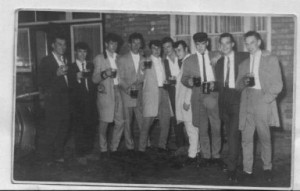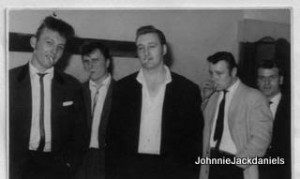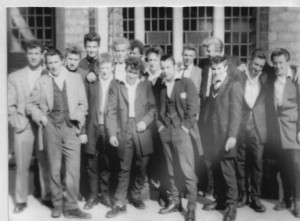The Violent Teddy Boy
1950s
The 50s began with rationing and austerity and ended with affluence. The 50s gave us Teddy Boys and Rock’n’Roll. The glamour of the American lifestyle heavily influenced Britain in the 50s. As well as adopting Rock’n’Roll music, our cars reflected American tastes when bright shiny chrome and fins appeared on British cars. The fifties was a decade of conservative attitudes and values, as well as a Conservative Government from 1951. By the end of the 50s though, the seeds of change had been sown. There were already stirrings of the freedom that would sweep the country in the 60s.
At the beginning of the 50s rationing was still in place. In the years following the War, Britain had to regain export markets to survive. Clement Atlee’s Labour Government, which won a landslide victory in 1945 with an ambitious social programme, was still struggling with economic worries in the early 50s. Nevertheless, the Welfare State and the National Health Service were already a part of our lives.
A glimmer of hope for the future came with the Festival of Britain in 1951. The Festival of Britain was described as ‘A tonic to the nation’. The space age buildings, such as the Skylon and Dome of Discovery (left), must have seemed like another world. Its main purpose though, was to show contemporary design at its best. People, starved of novelty, had their first taste of the new contemporary style which transformed homes in the 50s and the 60s.
The 50s was the age of television. In 50s America, it won and lost elections. In the UK we had just one channel at first. Screens were small, television sets were expensive, and everything was in black and white. Nevertheless, the television was the thing to have in the 50s. Many people bought one to watch the Queen’s Coronation in 1953, and by the end of the 50s, around three quarters of the population had access to a TV.
Economically the early 50s was a hard time. However, by the middle of the 50s Britain’s industry was running at full strength. Our lead over other European countries led to boom time in the UK. A high demand for skilled labour in heavily industrialised Britain meant high wage packets for many. There was a chance to enjoy affluence as never before. Prime Minister, Harold Macmillan captured the spirit of the age when he said “Some of our people have never had it so good”.
Rising prosperity meant teenagers in work had more money to spend. The 50s saw the first youth cult, the Teddy Boys. Their outlandish style of dress combined with acts of violence shocked British society. The 50s was also the decade of American Rock’n’Roll. Young people in the latest fashions danced to music despised by their parents.
As the fifties came to and end, a new era was just about to begin.
People were moving on from the struggle of life during the Second World War. Britain was rebuilding itself and by the mid-1950s there was plenty of work across Northampton. Young people had access to money like never before – and they wanted to spend it on fun. Their parents may have listened to the likes of Dickie Valentine and Frankie Laine but the teens wanted something new and exciting. A glut of American stars like Billy Haley and the Comets, Buddy Holly and Duane Eddy delivered just what they were looking for.Films were hugely important at the start, delivering new music to a large audience and creating an idea of teenage identity. The Girl Can’t Help It, starring Jayne Mansfield and Tom Ewell, was little more than a passable comedy about a gangster who hires a down-and-out press agent to make his blonde bimbo girlfriend a singing star.The movie was forgettable, but the musicians who provided the soundtrack will be remembered for ever – Little Richard, Fats Domino, Gene Vincent and Eddie Cochran.And it was the music that made The Girl Can’t Help It such a big hit.Blackboard Jungle had a massive impact simply because of Rock around the Clock. “Blackboard Jungle took a long time to come to Leicester,” remembers Malc. “The local authority had a group called the Leicester Watch Committee who would meet and decide what films we could see.“They banned it at first. But eventually they finally let it be shown iLeicester.” The music was hugely important to them. But it was the clothes that made the teddy boys stand out from the crowd. They were the first teenagers to take pride in what they looked like, dressing for show at every opportunity. Most distinctive was their long drape jackets – which had been inspired by the tailors of Savile Row who were keen to reintroduce the Edwardian style after the war. Some of these jackets had velvet collars and would be sold in many colours. This, coupled with a high necked white shirt collar, a ‘slim Jim’ tie and a brocade waistcoat shocked the adults and turned the heads of the girls.The clothes were tailor-made and could be paid for in installments. John Kenney, 70, of Goodwood, Leicester was desperate to be part of the scene and buy his first suit. His mother accompanied him down to Reynolds in Belgrave Gate to keep a careful eye on the suit he was buying.“Everyone went to Reynolds,” he says. “You could pay ‘on the knock’ there. There were others too – Jacksons in Gallowtree Gate, near to where Boots now stands. Leicester was a brilliant place at that time. “My mother came with me to the tailors, and on the way there she had tried to talk me out of it so I would buy a more traditional style suit. But as soon as I was in the shop she said ‘well… you better tell the man what you want’.”John left with his first drape jacket, but he would soon be back buying an array of styles and colours, ice blue, Burgundy and green among them.From Reynolds, it was a short walk to Irish Linen in Humberstone Gate for a teddy boy’s essential accessories.“We went there for our string ties,” says John.The teds, having spent time and money on their look, were not prepared to hide away. In fact they loved being on show.“People looked at us in amazement,” says Malc. “Our parents were surprised and disapproving, at the style and the music.“They couldn’t understand it, it was alien to them. Looking back, I suppose it’s no different to how we see kids today. We don’t understand their music either.”Having got the look, the teds established several hang-outs. The main location in the early days was the cafe at St Margaret’s Bus Station. It was an ideal meeting place. “The mods had their scooters,” says Malc, “the rockers had their motorbikes, we had the bus or Shanks’s pony!“We did a lot of walking about. The 1950s in Leicester was a different world, there were not that many places to go, especially on a Sunday. On a Sunday afternoon in Leicester you would see 70 or 80 teddy boys, just walking about.”They may have caught the eye, but in the main, the teddy boys insist, they stayed out of trouble. “If we had a fight, it was between two individuals, nothing to do with being a teddy boy,” says Ron.“There was a great camaraderie among us,” adds Malc. “We just loved talking about music – we weren’t targeted by other gangs.“The mods and rockers came later. People were shocked to see us and not everyone liked us because of the way we looked but we did not really attract any trouble.” The media, however, did not see it that way. Local and national headlines screamed controversy and implied they were hooligans. The Chronicle reported security was put on at Leicester’s New Walk museums to keep the Teddy Boys out.But the teenagers of the time were not that interested in the city’s collection of antiquities.They were more likely to be found in Sam’s cafe in Southgate, the York Road cafe, off Oxford Street, and the Spinney Hill Park cafe.These cafes and some of the pubs were installing jukeboxes which were playing all the new rock’n’roll records. The teds would gather round as the latest imported record spun.“The first few chords and first few words were distinct to that artist,” remembers Ron, “and we would know the singer straight away.“Once we heard something that we liked we had to go and get it.” But getting hold of the hits took a little time.“We got our singles from Breeze Records in Belgrave Gate,” adds Ron. “A single was 3s and 6d and an LP cost us 30 shillings. Often you had to order the song you wanted and it would take a week to arrive.” The popularity of the songs spread via the jukeboxes, word-of-mouth and reviews in New Musical Express.Malc remembers that the weekly music newspaper was showing pictures of teddy boys almost two years before they arrived in Leicester.“They had pictures of teddy boys in London in 1953,” he says. “I don’t think we saw one in Leicester until 1955. When we did, we just thought ‘wow’.” As the teenagers grew with the scene, they moved out of the cafes and into the pubs. Not all the bars wanted the teds hanging around, but some did, The Jolly Angler in Wharf Street, The Black Lion and the Nelson in the city centre and the Champion (now the Hansom Cab) in Charles Street made them welcome. They were particularly at home in the Three Cranes in Humberstone Gate. At that time it was ran by a team of old ladies – known to the teddy boys as Hilda, Ivy and Mrs Lovett.“One day Ivy said ‘I hope you boys don’t think we are three old cranes!’” says Ron. “But they were very good to us.” At that time De Montfort Hall was attracting some of the biggest names around to perform their songs live.“We saw Buddy Holly and the Crickets, the Everly Brothers and Duane Eddy there,” says John. “All the big acts would come. The names that perform there now just don’t compare.”And if there were no live performances there was a weekly event at the Palais de Dance, where the Life nightclub now stands in Humberstone Gate.Malc says: “It was 1s 6d to get in. We would meet girls there. They would be impressed by our clothes, especially if you had a velvet collar – they really appreciated the style.”Times moved on and fashions changed, along with Peggy Sue, many of the teddy boys got married.But more than 50 years since they heard their first rock’n’roll record, Ron, Malc, John and all the other Leicester teds still have the music in their blood.In fact their children grew up listening to the sounds that they loved.Ron said: “My kids grew up listening to it. They loved it. In fact my 10-year-old granddaughter rang me the other day to say she was listening to Blueberry Hill by Fats Domino.”
The hey-day of the teddy boy fell in that five-year period from 1955 to 1960. By the turn of the decade, other youth cults had formed. But it was a group of lads wearing clothes styled on a forgotten age who became the city’s first teenage subculture and who had enjoyed Leicester’s first taste of rock‘n’roll.
Cinemas & dance halls
Cinemas, dance halls and other places of entertainment in South east London are closing their doors to youths in ‘Edwardian’ suits because of gang hooliganism. The ban, which week by week is becoming more generally applied, is believed by the police to be one of the main reasons for the extension of the area in which fights with knuckle dusters, coshes, and similar weapons between bands of teenagers can now be anticipated. In cinemas, seats have been slashed with razors and had dozens of meat skewers stuck into them.
Brighton and Hove Herald: Youths slashed by Teddy Boy thugs
20 November 1954
Dance Hall Gang Fight Sequel – ‘Teddy Boys’ Will Be Screened
Strong action is expected by both police and dance hall managements to prevent any repetition of the gang fight started at the week-end by ‘Teddy Boys’ from London in which three innocent bystanders received nasty injuries. The three victims, all local men, were slashed it is believed with shoe-makers knives, sharpened to a razor edge. Every person seeking admission to the Regent dance hall to-night will be scrutinised by the ballroom manger, Mr Lionel Stewart. “I dont have to bar everybody who looks like a Teddy Boy, but I shall sort them out and those with big rings just wont get in” he told the Herald last night. “They dont frighten me”.The difficulty in ‘screening’ would-be dancers is, of course, that the Edwardian fashion is just a passing phase with many of the younger generation, just as harmless as ‘Oxford Bags’ were in the 1920s. Many of the younger men who affect it are decent and law-abiding citizens. But a small minority of vicious young thugs have adopted it as a uniform and they go from town to town picking quarrels with their local counterparts.
A menace 
The ‘Teddy Boys’ are regarded as a greater menace than the race gangs were just after the first World War. The race gangs fought amongst themselves, and normally did not interfere with other people. But the modern thugs, as is shown by Saturday nights happenings, lash out indiscriminately at innocent people trying to keep out of harms way. The three local men who were injured were not together. Basil Ferrari, aged 25, of Hornby Road, had 13 stitches inserted in his face. Richard Thompson, aged 20, received a four-inch gash on the back of the neck. John Wadey, aged 20, had three stitches in a cut on his back. Women and girls were knocked over during the scuffle in the bar of the Regent ballroom. Basil Ferrari, a van driver, said: “I was sitting by myself at a table in the bar waiting for a friend, when I saw four fellows in Edwardian dress attack another man”. He picked up a chair to defend himself.
Table knocked over
“There was a rush towards men, and my table was knocked over. I got up to get out of the way and someone jumped on my back. I felt a sharp pain across my face. The man on my back seemed to be pulled off, and I got out as fast as I could. Blood was pouring down my face. I found there were slashes in my jacket, in the front and the back.” The cut in the back of the jacket, which was soaked in blood, was six inches long and must have been caused with an extremely sharp instrument. Richard Thompson, a carpenters apprentice, said: “I am very interested in playing the drums and I was standing listening to the band near the entrance of the bar, when I saw a chair hurtling through the air. I ducked and tried to avoid it, but I felt something cut my neck. It was all over in flash and I have not idea who did it.” said John Wadey, a general dealer, who has just completed his National Service in the Queens Royal Regiment: “I was standing by the bar trying to get a drink when a crowd of fellows surged towards me. One was swinging a chair. I tried to get out of the way, but I was struck over the head with a chair, and then I felt something sharp in my back. When I got out in the street I found blood coming form my back.” There was a six-inch slash in Wadeys jacket and shirt, which were both blood-stained, and a gash in his back, just above hip. Wadey did not get a clear view of his assailants, but his brother, Patsy, aged 17, who was in the dance hall, said, “The fellow swinging the chair was about six feet and wearing a pinstripe suit. The other four were all over medium height and in Edwardian clothes. Three were in clerical grey and the other one in Donegal tweed.”
Brief but violent
The struggle was brief by violent, After it was over the ‘Teddy boy’ gangsters ran down the stairs and out just before the police arrived. A retired police officer employed at the Regent tried to head them off by going down in lift, but he “Teddy boys” go down the stairs too quickly for him. A cordon was thrown across Brighton station, but it is believed that the gang got away in a car. Earlier in the evening three men in Edwardian dress ordered a hired car proprietor waiting at the bottom of West Street to drive them to the Regent. He pointed out that he was engaged and they became extremely aggressive, but went away when he picked up a spanner.
Leave a Reply
You must be logged in to post a comment.



